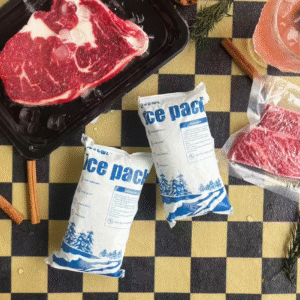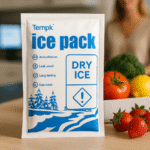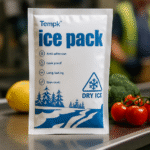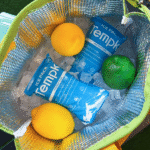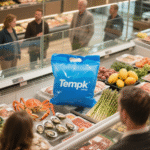When it comes to vaccine transportation, maintaining the correct temperature is vital for ensuring their potency upon arrival. Dry ice pack sheets have become an essential tool in cold chain logistics, offering a reliable, efficace, and safe solution for shipping vaccines that require ultra-low temperatures. Dans cet article, we will guide you through everything you need to know about using dry ice pack sheets for vaccine shipping, from best practices to safety and compliance tips for 2025.
-
What are dry ice pack sheets and why are they essential for vaccine shipping?
-
How do you properly use dry ice pack sheets for vaccine shipments?
-
What are the safety considerations and regulatory requirements for shipping vaccines with dry ice?
What Are Dry Ice Pack Sheets and Why Are They Essential for Vaccine Shipping?
La glace sèche est un dioxyde de carbone solide, sublimating directly from solid to gas at a temperature of -78.5°C. This extreme cold temperature makes it ideal for maintaining the ultra-low temperatures required for vaccine preservation. Contrairement à la glace ordinaire, La glace sèche ne fonde pas dans l'eau, preventing water damage to sensitive pharmaceutical products.
Why Dry Ice Pack Sheets Are Critical for Vaccine Shipping
Dry ice pack sheets are specially designed for temperature-sensitive shipments like vaccines. These sheets provide consistent cooling, ensuring the vaccine remains stable throughout transit. Their benefits include:
-
Ultra-Low Temperature Maintenance: Dry ice keeps vaccines at temperatures well below freezing, which is crucial for maintaining their efficacy.
-
No Residual Moisture: Contrairement aux packs de gel, dry ice sublimates without leaving behind any water, reducing contamination risk.
-
Durée de refroidissement prolongée: Depending on the amount used, dry ice pack sheets can maintain a steady temperature for several hours, even during long shipments.
Key Vaccine Types and Their Temperature Needs
| Vaccine Type | Ideal Temperature Range | Dry Ice Pack Sheet Benefit |
|---|---|---|
| Vaccins à ARNm | -70° C à -80 ° C | Keeps vaccines stable and cold |
| Inactivated Vaccines | 2°C à 8°C | Provides steady cooling without freezing |
| Biologic Samples | -20° C ou plus bas | Maintains stability during transport |
How to Use Dry Ice Pack Sheets for Vaccine Shipping Effectively?
Using dry ice pack sheets for vaccine shipping is not just about placing them in a box—precision is essential to ensure vaccines stay within the required temperature range. Here’s how to do it correctly:
Best Practices for Using Dry Ice Pack Sheets
-
Choose the Right Dry Ice Pack Sheets:
Select sheets specifically designed for the temperature range of your vaccine shipment. Par exemple, thicker sheets are needed for mRNA vaccines, which require ultra-low temperatures. -
Calculate the Correct Amount of Dry Ice:
The amount of dry ice needed depends on the size of the shipment, the temperature requirements of the vaccine, et la durée du transport. En général, 5-10 lbs is enough for a 24-hour shipment of mRNA vaccines, but larger shipments may require more. -
Pack Efficiently:
Dry ice pack sheets should be distributed evenly around the vaccine containers. Ensure the sheets cover the top, bas, and sides to prevent any temperature fluctuations during transit. -
Surveiller la température:
Use temperature monitors within the package to track the internal temperature of the shipment. This ensures vaccines remain within the safe temperature range throughout the journey.
Pour la pointe:
Always check with your shipping carrier for any additional dry ice regulations, as specific requirements can vary depending on the carrier.
Key Safety Considerations When Shipping Vaccines with Dry Ice
While dry ice is effective at keeping vaccines cold, it also comes with certain risks. Understanding these risks and following safety guidelines is crucial for a smooth and safe shipping process.
Safety Guidelines for Dry Ice Shipping
-
Assurer une bonne ventilation:
Dry ice releases carbon dioxide gas as it sublimates. Ensure your shipping containers have proper ventilation to allow gas to escape and prevent dangerous gas buildup. -
Utiliser des conteneurs isolés:
To prevent excessive sublimation and maintain temperature control, use insulated and vented containers designed for dry ice shipments. -
Manipuler avec soin:
Dry ice can cause severe frostbite if it comes into direct contact with skin. Always use protective gloves when handling dry ice. -
Étiquetage approprié:
Containers with dry ice must be clearly labeled with “Glace sèche” and the weight of the dry ice. This is necessary for safe handling by the carrier.
How Long Can Dry Ice Pack Sheets Maintain Temperature for Vaccine Shipments?
The duration that dry ice pack sheets can maintain the required temperature depends on several factors, y compris la quantité de neige carbonique utilisée, the insulation of the container, and the shipping duration.
Dry Ice Sublimation Timelines
| Vaccine Type | Dry Ice Quantity Required | Sublimation Time |
|---|---|---|
| Vaccins à ARNm | 5-10 lbs | 18-24 heures |
| Inactivated Vaccines | 10-15 lbs | 24-48 heures |
| Biologic Samples | 15-20 lbs | 24-36 heures |
Trends in Dry Ice for Vaccine Shipping in 2025
À mesure que l'industrie de la logistique de la chaîne du froid évolue, advancements in technology and sustainability practices are shaping the future of dry ice shipping. Here are some key trends:
Dernières innovations
-
Emballage à température contrôlée:
New insulation materials are being developed to extend the lifespan of dry ice, enabling temperature control over longer distances. -
Surveillance de la température en temps réel:
The rise of real-time temperature monitoring systems allows for continuous tracking of vaccine temperature throughout transit. -
Sustainability Practices:
With growing environmental awareness, more eco-friendly dry ice alternatives are being explored, alongside improved recycling practices.
Insistance au marché
The demand for dry ice in vaccine shipping is expected to increase, driven by the ongoing global vaccine distribution. This growing demand is prompting innovations in packaging and shipping methods to improve efficiency and sustainability.
Questions fréquemment posées
How much dry ice is needed for vaccine shipments?
The amount of dry ice required depends on the shipment size, temperature needs, and transport duration. Typiquement, 5-10 lbs of dry ice is sufficient for a 24-hour shipment.
Can dry ice damage vaccines during transport?
When used properly, dry ice does not damage vaccines. Cependant, improper packing or excessive exposure to dry ice can freeze the vaccine, which might compromise its efficacy.
Conclusion et recommandations
Dry ice pack sheets play a crucial role in ensuring vaccines are transported within their required temperature ranges. En suivant les meilleures pratiques d'emballage, manutention, and monitoring temperature, you can ensure safe delivery.
Étapes suivantes:
To ensure your vaccines arrive safely, use high-quality dry ice pack sheets, calculate the correct amount of dry ice, and always follow safety guidelines. Consider using real-time temperature monitoring to provide added assurance.
À propos du tempk
Et tempk, we specialize in cold chain logistics, providing solutions tailored for safe and efficient vaccine shipping with dry ice pack sheets. Our commitment to quality and reliability ensures that temperature-sensitive products reach their destination safely.
For a consultation on your vaccine shipping needs, Contactez-nous aujourd'hui.






